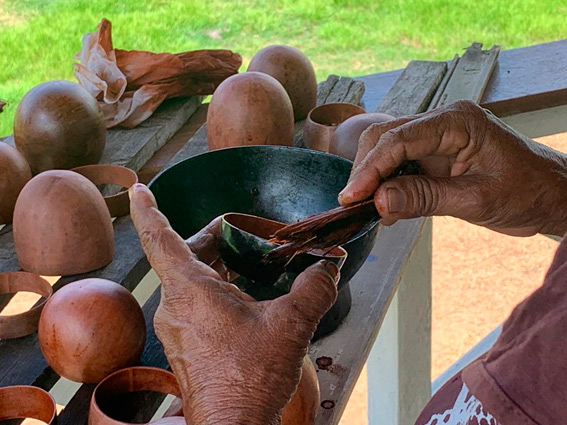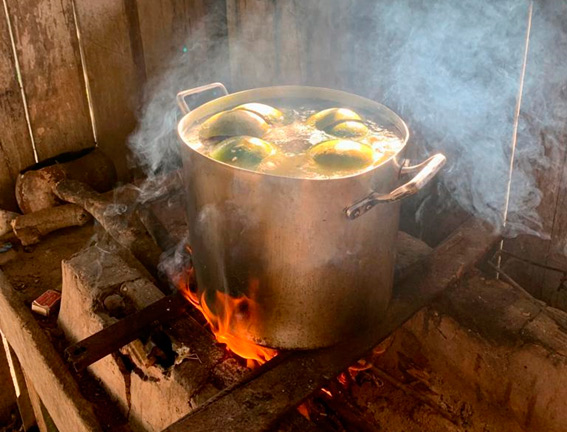

Cuias ANT. Br. 193 and ANT. Br. 194. Science Museum of the University of Coimbra (photo by Renata Martins, Coimbra, Portugal, 2023. Image reproduced with permission of the Portuguese Research Infrastructure of Scientific Collections)
The pieces, made in the Amazon, were matched with lacquer and decorated with motifs that replicated European and Asian embroidery patterns.
The pieces, made in the Amazon, were matched with lacquer and decorated with motifs that replicated European and Asian embroidery patterns.

Cuias ANT. Br. 193 and ANT. Br. 194. Science Museum of the University of Coimbra (photo by Renata Martins, Coimbra, Portugal, 2023. Image reproduced with permission of the Portuguese Research Infrastructure of Scientific Collections)
By José Tadeu Arantes | Agência FAPESP – Household utensils or objects for ritual use, gourds are present in various cultural environments in Brazil, especially in indigenous or riverside communities, but also in large cities in the Amazon region, such as Belém, capital of the state of Pará. “Gourds are believed to be among the first cultivated plants in the Amazon, and their use is probably even older than that of ceramics,” says researcher Renata Maria de Almeida Martins, professor at the Faculty of Architecture and Urbanism of the University of São Paulo (FAU-USP), in Brazil, and coordinator of Labya-Yala – the Decolonial Studies Laboratory – and the project “Barroco-açu: Portuguese America in the Artistic Geography of the Global South”, which received a FAPESP research grant in the Young Investigators – Phase 2 modality.
As part of the project, Martins conducted a detailed analysis of the production of varnished gourds and calabashes in the 18th-century captaincy of colonial Brazil, called Grão-Pará. These objects are preserved in museums in Portugal. An article on this subject was published in the journal Heritage.
“The gourds were made by Indigenous women who used sophisticated techniques to create a black, shiny and durable finish, like an ‘Amazonian lacquer.’ These fruits had their iconographic fields modified and were refashioned by decorations with motifs inspired by the local flora and fauna, but also by patterns for European and Asian embroidery, which circulated worldwide, reflecting the artistic exchanges of the time, as also happened with objects covered with mopa-mopa, also called Barniz de Pasto, in Colombia, or with maque, the Mexican lacquer,” says Martins.
It is important to note that these gourds were not made spontaneously and randomly, but were produced in manufactories maintained by settlers or within the framework of religious missions in the Amazon. The craft of gourd painting was recognized at the beginning of the 18th century. The products of these “factories” were mostly destined for the European market, participating in a process of globalization that was already underway at the time.

Dona Marinalva Correia de Sousa and gourds at different stages of production (photo: Renata Maria Martins, Carapanatuba, state of Pará, Brazil, 2023)
The refashioned gourds were produced mainly in the village of Monte Alegre (formerly the indigenous village of Gurupatuba, now Monte Alegre, in the state of Pará), in other places in the Lower Amazon region, and also in Belém, the capital of Grão-Pará. The naturalist Alexandre Rodrigues Ferreira (1756-1815) collected several of them in his Philosophical Journey, which are now in the collections of the Maynense Museum of the Lisbon Academy of Sciences and the Science Museum of the University of Coimbra. In his account, Ferreira states that between 5,000 and 6,000 gourds were produced each year in the village of Monte Alegre, most of which were sent to Lisbon. “Their varied and complex decorations, based on Indigenous traditions and/or with Asian and European inspirations, are examples that show the creative and artistic practices of resistance of Indigenous, African and mestizo women,” says Martins.
In addition to studying 18th-century gourds, in 2023 the researcher visited the community of Carapanatuba, in the Aritapera region, in the municipality of Santarém, in the Lower Amazon, where these objects are still produced, now by free and empowered women from the riverside region. The Association of Santarém Riverside Craftswomen (Asarisan), founded in 2003, has brought together artists from the five communities of Aritapera and has played a key role in ensuring that the “Way of Making Gourds from the Lower Amazon” was included in the Register of Knowledge of the National Institute of Historical and Artistic Heritage (IPHAN), as part of Brazil’s Cultural Heritage, in 2015.
“I found, as other scholars have also reported, that, for the most part, production still follows the same process described by Ferreira. Women like Lélia Maduro, Silvane Maduro, Marinalva Correia, Francisca Pereira, Socorro Pereira and others from the communities in the Aritapera region preserve the ancestral knowledge about nature, the rivers, the plants and the local animals. As well as the long process of preparing gourds varnished with cumatê and 'embroidered' with incisions,” says Martins.
In the garden around the house of Dona (“Mistress”) Lélia and her husband, Senhor (“Mister”) Antônio, there are different types of gourd trees (Crescentia cujete), which produce round or oval fruits of different sizes. The women pick them when they are ripe: when they make a certain sound.

Gourd being prepared by Dona Marinalva Correia de Sousa (photo: Renata Maria Martins, Carapanatuba, state of Pará, Brazil, 2023)
The fruits are then cut open with a machete or saw, and the resulting gourds are placed in a large pot of boiling water to soften the shells. Then, the outer shell of each gourd is carefully scraped with a blade, the edge is smoothed with the rough tongue of the pirarucu fish (Arapaima gigas) and the inside with the scales of the same fish. The final preparation for the application of the varnish is done by rubbing the inside and outside with the large leaves of the embaúba tree (Cecropia), a species also found in the area near the family’s home. The treated but unvarnished gourd is called “pitinga.”
The “lacquering” process is done by applying tincture of cumatê, a reddish liquid obtained by infusing the bark of another tree of the region, the cumatezeiro (Myrcia atramentifera). After being painted with several layers of dye, the gourds are placed on a bed of sand or ashes, sprinkled with human urine and left covered for an entire night. The chemical reaction between the components of the dye and the urine transforms the reddish dye into a kind of shiny black “lacquer.” This technique, developed by Indigenous women of the Lower Amazon, produces a result comparable to and even superior to the best lacquer from China (Rhus vernicifera or Rhus verniciflua), according to reports from the 18th century.
“After all these steps, the gourds are decorated by making incisions with a small knife. The incision removes the varnish and allows the light background to shine through. Painting by applying vegetable or mineral dyes to the bare surface, which was widely used on gourds in the 18th century, is hardly used in the region today, although the dye-producing plants are known to the riverside artists,” says Martins.
The iconography of Indigenous origin, consisting of geometric and abstract motifs, is increasingly used in today’s gourds, which are produced for use or trade. “However, even in colonial times, the production of gourds, in addition to serving the export market, also had important functions in the ritual context. In his memoirs, Ferreira recounted the resistance of the Indigenous women of Monte Alegre to selling certain gourds, which had beads and muiraquitãs (a kind of Amazonian amulet), because of their sensitive meanings in the social relations of the communities,” explains Martins.
Produced by women, gourds are also symbolically associated with fertility, creation myths, and the ancient healing practices of Indigenous peoples, and are still widely used today to prepare and pour therapeutic baths and blessings, as well as to serve typical Amazonian foods such as tacacá.

Gourds being boiled to remove the husks, in the stilt house of Dona Lelia Almeida Maduro (photo: Renata Maria Martins, Carapanatuba, state of Pará, Brazil, 2023)
In the 18th century, however, the workshops set up in the villages and religious missions redirected this ancestral tradition to cater for the European market, which was hungry for luxury items as well as objects considered “exotic.” Asian or Asian-inspired European pieces, such as porcelain, silk, embroidery, and even ivory crucifixes, served as models for locally produced objects that reinterpreted the imported ones. “Indigenous and Afro-Indigenous artists used techniques such as inlaying, marquetry, and gilding, adapting Amazonian materials and plants such as copaiba (Copaifera langsdorffii) and West Indian locust (Hymenaea courbaril), for example, to create effects similar to the gilding found on Asian objects. The participation of Indigenous women, their intimacy with the nature of the forest, was fundamental in this process. This contribution and protagonism, which is often made invisible, is essential for understanding the complexity of cultural and artistic relations in the Amazon, in colonial times and today,” concludes Martins.
The article “Lacquers of the Amazon: Cuias, Cumatê and Colours by Indigenous Women in Grão-Pará in the 18th Century” can be accessed at www.mdpi.com/2571-9408/7/9/230.
Republish
The Agency FAPESP licenses news via Creative Commons (CC-BY-NC-ND) so that they can be republished free of charge and in a simple way by other digital or printed vehicles. Agência FAPESP must be credited as the source of the content being republished and the name of the reporter (if any) must be attributed. Using the HMTL button below allows compliance with these rules, detailed in Digital Republishing Policy FAPESP.





